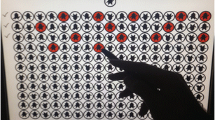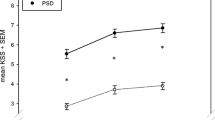Abstract
Excessive daytime sleepiness, as a cardinal symptom of obstructive sleep apnea, leads to a reduced ability to drive, particularly among professional drivers. Alongside test procedures used in sleep medicine such as the Multiple Sleep Latency Test (MSLT) and Maintenance of Wakefulness Test (MWT), driving simulators that provide realistic simulation of road traffic can also be used to diagnose performance. The aim of this study was to use reaction time in a driving simulator as an indicator of the ability to drive in patients with obstructive sleep apnea.
Zusammenfassung
Exzessive Tagesschläfrigkeit als Leitsymptom der obstruktiven Schlafapnoe führt insbesondere bei Berufskraftfahrern zu einer verminderten Fahrtauglichkeit. Neben schlafmedizinischen Testverfahren wie dem Multiplen Schlaflatenztest (MSLT) oder dem Multiplen Wachbleibetest (MWT) können Fahrsimulatoren, die eine realistische Simulation des Straßenverkehrs gewährleisten, zur Leistungsdiagnostik verwendet werden. Ziel dieser Studie war die Applikation der Reaktionszeit im Fahrsimulator als Indikator für die Fahrtauglichkeit bei Patienten mit obstruktiver Schlafapnoe.




Similar content being viewed by others
References
Birk M, Dragon L, Niethammer R et al (2011) Dynamik der Kraftfahrzeuge. In: Robert Bosch GmbH (ed) Kraftfahrtechnisches Taschenbuch. Vieweg+Teubner, Wiesbaden, pp 324–353
Buysse DJ, Reynolds CF III, Monk TH et al (1989) The Pittsburgh sleep quality index: a new instrument for psychiatric practice and research. Psychiatry Res 28:193–213
Davenne D, Lericollais R, Sagaspe P et al (2012) Reliability of simulator driving tool for evaluation of sleepiness, fatigue and driving performance. Accid Anal Prev 45:677–682
Engström J, Johansson E, Östlund J (2005) Effects of visual and cognitive load in real and simulated motorway driving. Transp Res Part F Traffic Psychol Behav 8:97–120
Green M (2000) “How long does it take to stop?” Methodological analysis of driver perception-brake times. Transportation Hum Factors 2:195–216
Greenshields BD (1936) Reaction time in automobile driving. J Appl Psychol 20:353–358
Häkkänen H, Summala H (2000) Sleepiness at work among commercial truck drivers. Sleep 23:1–9
Heinzer R, Vat S, Marques-Vidal P et al (2015) Prevalence of sleep-disordered breathing in the general population: the HypnoLaus study. Lancet Respir Med 3:310–318
Howard ME, Desai AV, Grunstein RR et al (2004) Sleepiness, sleep-disordered breathing, and accident risk factors in commercial vehicle drivers. Am J Respir Crit Care Med 170:1014–1021
Johns MW (1991) A new method for measuring daytime sleepiness: the Epworth sleepiness scale. Sleep 14:540–545
Kennedy RS, Lane NE, Berbaum KS et al (1993) Simulator sickness questionnaire: an enhanced method for quantifying simulator sickness. Int J Aviat Psychol 3:203–220
Kolasinski EM (1995) Simulator sickness in virtual environments. United States Army Research Institute for the Behavioral and Social Sciences, Alexandria, VA
Littner MR, Kushida C, Wise M et al (2005) Practice parameters for clinical use of the multiple sleep latency test and the maintenance of wakefulness test. Sleep 28:113–121
McGehee DV, Mazzae EN, Baldwin GHS (2000) Driver reaction time in crash avoidance research: validation of a driving simulator study on a test track. Proc Hum Factors Ergon Soc Annu Meet 44:3-320–3-323
Neukum A, Grattenthaler H (2006) Kinetose in der Fahrsimulation (Projekt: Simulation von Einsatzfahrten im Auftrag des Präsidiums der Bayerischen Bereitschaftspolizei, Abschlussbericht – Teil II). IZVW, Würzburg
Orth M, Kotterba S (2011) Tagesschläfrigkeit und Unfallhäufigkeit beim obstruktiven Schlafapnoe-Syndrom. In: Wilhelm B, Stephan E, Dittmann V (eds) Tagesschläfrigkeit – Gefahren und Konsequenzen für den Straßenverkehr 6. Gemeinsames Symposium der DGVM und DGVP, Tübingen, 1.–2. Oktober 2010 Kirschbaum, Bonn, pp 51–54
Pack AI, Maislin G, Staley B et al (2006) Impaired performance in commercial drivers. Role of sleep apnea and short sleep duration. Am J Respir Crit Care Med 174:446–454
Pizza F, Contardi S, Mondini S et al (2009) Daytime sleepiness and driving performance in patients with obstructive sleep apnea: comparison of the MSLT, the MWT, and a simulated driving task. Sleep 32:382–391
Pizza F, Contardi S, Mostacci B et al (2004) A driving simulation task: correlations with multiple sleep latency test. Brain Res Bull 63:423–426
Powelleit M, Muhrer E, Vollrath M et al (2015) Verhaltensbezogene Kennwerte zeitkritischer Fahrmanöver. Schriftenreihe Berichte der Bundesanstalt für Straßenwesen, Fahrzeugtechnik, vol 100. Fachverlag NW, Bremen
Recarte MA, Nunes LM (2003) Mental workload while driving: effects on visual search, discrimination, and decision making. J Exp Psychol Appl 9:119–137
Stuck BA, Maurer JT, Schredl M et al (2009) Praxis der Schlafmedizin. Schlafstörungen bei Erwachsenen und Kindern; Diagnostik, Differentialdiagnostik und Therapie. Springer, Heidelberg
Uhr MBF, Felix D, Williams BJ et al (2003) Comparison of the emotional response between real world environment and simulation. Proc Hum Factors Ergon Soc Annu Meet 47:2142–2146
Author information
Authors and Affiliations
Corresponding author
Ethics declarations
Conflict of interest
M. Trost and A. Machleit-Ebner declare that they have no competing interests. M. Neddermann has received speaker’s fees from Löwenstein Medical, Novartis, Berlin-Chemie, ResMed, Inspire, and Fisher & Paykel Healthcare. P. Young has received speaker’s fees from Vanda, Medice, Sanofi Genzyme, Löwenstein Medical, Biogen, and Pharnext.
All procedures performed in studies involving human participants were in accordance with the ethical standards of the institutional and/or national research committee and with the 1975 Helsinki declaration and its later amendments or comparable ethical standards. Informed consent was obtained from all individual participants included in the study.
Rights and permissions
About this article
Cite this article
Trost, M., Machleit-Ebner, A., Neddermann, M. et al. Assessment of ability to drive in obstructive sleep apnea patients using a driving simulator. Somnologie 23, 36–42 (2019). https://doi.org/10.1007/s11818-019-0192-x
Received:
Accepted:
Published:
Issue Date:
DOI: https://doi.org/10.1007/s11818-019-0192-x




